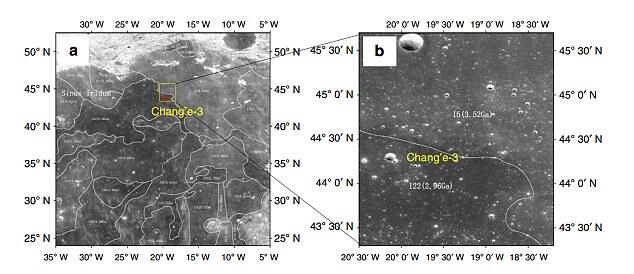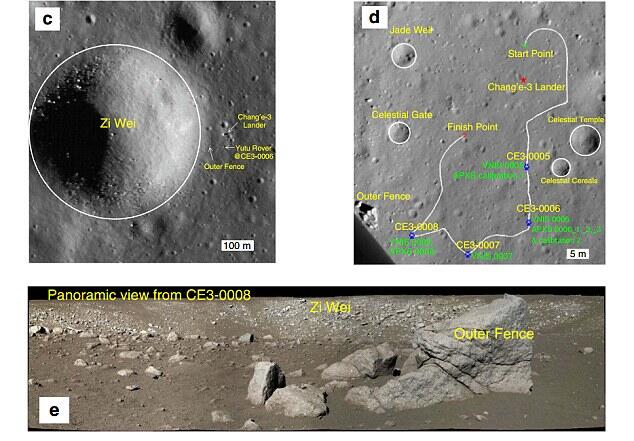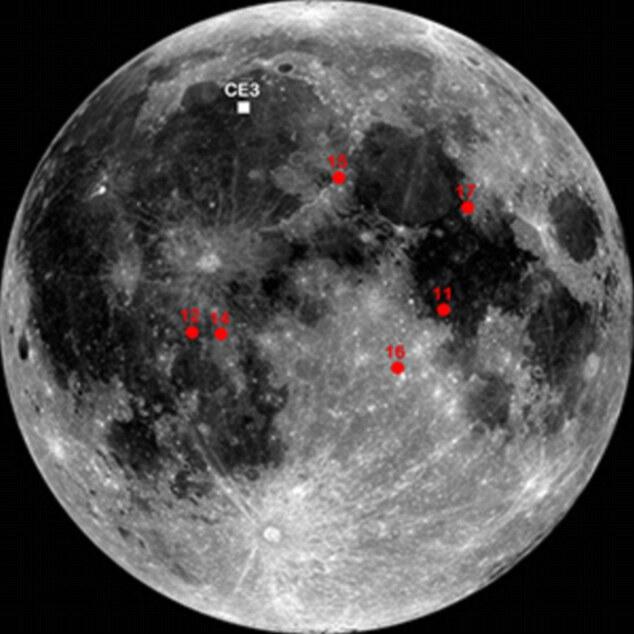- Beranda
- Komunitas
- News
- Berita Luar Negeri
Pesawat luar Angkasa China " Jade Rabbit " Menemukan Moon Rock
TS
jiu.gui
Pesawat luar Angkasa China " Jade Rabbit " Menemukan Moon Rock
A type of titanium-rich rock, never before seen by researchers, has been discovered on the surface of the moon.
Samples of the unique basalt were gathered by the Chinese rover Jade-Rabbit and researchers have now studied the rock to learn more about the moon's volcanic surface.
In particular, the rock contains a unique mixture of titanium dioxide and olivine, which makes it different from any of the samples returned by the Nasa Apollo missions.
.

The unmanned Chang'e-3 probe and the Jade Rabbit rover touched down on a vast flat flood plain formed of a unique type of volcanic basalt.
Analysis of the measurements the rover took while exploring the site have revealed the area formed surprisingly recently and may be among the youngest areas on the lunar surface.
While the surface of the moon is largely thought to have been shaped by volcanic eruptions that took place some 3 to 4 billion years ago.
But the unusual volcanic basalt rock discovered by the Chinese rover appears to be just 2.96 billion years old.
It has been found to contain a unique mixture of minerals that has high levels of titanium dioxide and also another green mineral called olivine.
Researchers who examined the measurements said they are unlike any of the lunar basalt samples returned by the Nasa Apollo missions.
'The diversity tells us that the Moon's upper mantle is much less uniform in composition than Earth's,' explained Dr Bradley Jolliff, a planetary scientist at Washington University in St Louis.
'And correlating chemistry with age, we can see how the moon's volcanism changed over time.
'The variable titanium distribution on the lunar surface suggests that the moon's interior was not homogenised.
'We're still trying to figure out exactly how this happened. Possibly there were big impacts during the magma ocean stage that disrupted the mantle's formation.'
The Chang'e-3 lander and Jade Rabbit rover touched down on the lunar surface in 2013.
It was China's first mission to land on the moon and the first from Earth since the Apollo missions.
The rover began to suffer mechanical problems in 2014 and was put into a hibernation mode as engineers struggled to fix the problems.
The samples were taken from a fresh impact crater on the smooth basalt flood plain which had helped to excavate out the bedrock beneath the layer of lunar dust, called the regolith.
Scientists from Shandong University in Weihai, China, whose findings are published in the journal Nature Communications, said the analysis seems to agree with measurements taken by orbiting satellites


China's glitch-hit Jade Rabbit rover (pictured) managed to take samples of the bedrock close to its landing site before it was hit by mechanical problems. The data it sent back has revealed the area is covered in a unique type of basalt rock that has high levels of titanium and olivine in it


The moon is thought to have formed around 4.5 billion years ago when a Mars-sized object collided with the Earth, creating a large molten body that broke away.
It cooled to form a crust, mantle and core, but a build-up of radioactive elements in the interior then remelted parts of the mantle causing eruptions around 500 million years ago.
Dr Alian Wang, a earth and planetary scientist at Washington University, said usually minerals crystalise in a certain order with magnesium and iron rich minerals forming first and sinking through the magma.
Titanium, which becomes bound in a mineral called ilmenite, usually doesn't crystalise until a very late stage and because it is so dense it sinks into the mantle.
However, the measurements made by Jade Rabbit reveal basalt close to the surface that are rich in both ilmenite and a mineral called olivine, which form at different times.
The scientists believe that the area was covered in a magma ocean relatively late in the moon's development which caused olivine to rise and the ilmenite to sink, meaning they mixed.
Dr Jolliff added: 'That makes more sense because iron-enriched olivine and ilmenite are more likely to occur together.
'You still have to explain how you get to an olivine-rich and ilmenite-rich rock. One way to do that would be to mix, or hybridise, two different sources.'

Source
Samples of the unique basalt were gathered by the Chinese rover Jade-Rabbit and researchers have now studied the rock to learn more about the moon's volcanic surface.
In particular, the rock contains a unique mixture of titanium dioxide and olivine, which makes it different from any of the samples returned by the Nasa Apollo missions.
.

The unmanned Chang'e-3 probe and the Jade Rabbit rover touched down on a vast flat flood plain formed of a unique type of volcanic basalt.
Analysis of the measurements the rover took while exploring the site have revealed the area formed surprisingly recently and may be among the youngest areas on the lunar surface.
While the surface of the moon is largely thought to have been shaped by volcanic eruptions that took place some 3 to 4 billion years ago.
But the unusual volcanic basalt rock discovered by the Chinese rover appears to be just 2.96 billion years old.
It has been found to contain a unique mixture of minerals that has high levels of titanium dioxide and also another green mineral called olivine.
Researchers who examined the measurements said they are unlike any of the lunar basalt samples returned by the Nasa Apollo missions.
'The diversity tells us that the Moon's upper mantle is much less uniform in composition than Earth's,' explained Dr Bradley Jolliff, a planetary scientist at Washington University in St Louis.
'And correlating chemistry with age, we can see how the moon's volcanism changed over time.
'The variable titanium distribution on the lunar surface suggests that the moon's interior was not homogenised.
'We're still trying to figure out exactly how this happened. Possibly there were big impacts during the magma ocean stage that disrupted the mantle's formation.'
The Chang'e-3 lander and Jade Rabbit rover touched down on the lunar surface in 2013.
It was China's first mission to land on the moon and the first from Earth since the Apollo missions.
The rover began to suffer mechanical problems in 2014 and was put into a hibernation mode as engineers struggled to fix the problems.
The samples were taken from a fresh impact crater on the smooth basalt flood plain which had helped to excavate out the bedrock beneath the layer of lunar dust, called the regolith.
Scientists from Shandong University in Weihai, China, whose findings are published in the journal Nature Communications, said the analysis seems to agree with measurements taken by orbiting satellites


China's glitch-hit Jade Rabbit rover (pictured) managed to take samples of the bedrock close to its landing site before it was hit by mechanical problems. The data it sent back has revealed the area is covered in a unique type of basalt rock that has high levels of titanium and olivine in it


The moon is thought to have formed around 4.5 billion years ago when a Mars-sized object collided with the Earth, creating a large molten body that broke away.
It cooled to form a crust, mantle and core, but a build-up of radioactive elements in the interior then remelted parts of the mantle causing eruptions around 500 million years ago.
Dr Alian Wang, a earth and planetary scientist at Washington University, said usually minerals crystalise in a certain order with magnesium and iron rich minerals forming first and sinking through the magma.
Titanium, which becomes bound in a mineral called ilmenite, usually doesn't crystalise until a very late stage and because it is so dense it sinks into the mantle.
However, the measurements made by Jade Rabbit reveal basalt close to the surface that are rich in both ilmenite and a mineral called olivine, which form at different times.
The scientists believe that the area was covered in a magma ocean relatively late in the moon's development which caused olivine to rise and the ilmenite to sink, meaning they mixed.
Dr Jolliff added: 'That makes more sense because iron-enriched olivine and ilmenite are more likely to occur together.
'You still have to explain how you get to an olivine-rich and ilmenite-rich rock. One way to do that would be to mix, or hybridise, two different sources.'

Source
0
5.4K
34
Komentar yang asik ya
Urutan
Terbaru
Terlama
Komentar yang asik ya
Komunitas Pilihan